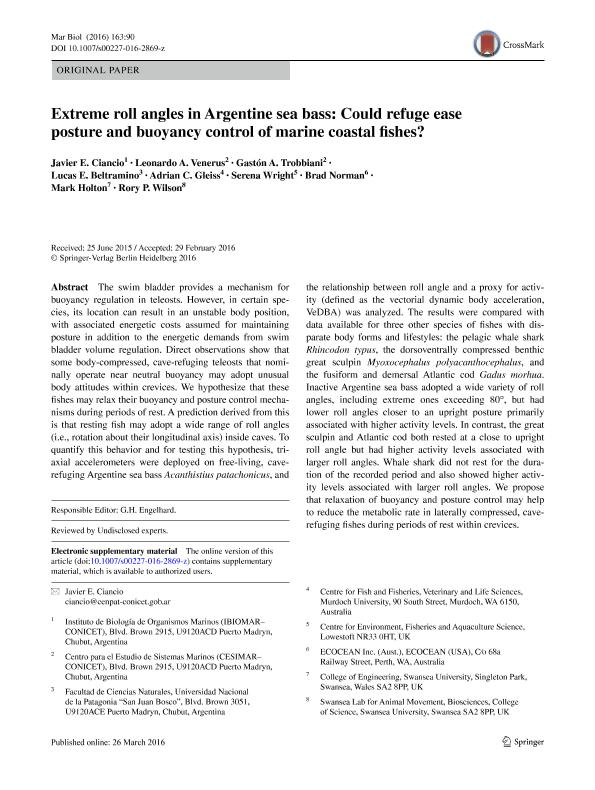Mostrar el registro sencillo del ítem
dc.contributor.author
Ciancio Blanc, Javier Ernesto

dc.contributor.author
Venerus, Leonardo Ariel

dc.contributor.author
Trobbiani, Gastón Andres

dc.contributor.author
Beltramino, Lucas Esteban

dc.contributor.author
Gleiss, Adrian C.
dc.contributor.author
Wright, Serena
dc.contributor.author
Norman, Brad
dc.contributor.author
Holton, Mark
dc.contributor.author
Wilson, Rory P.

dc.date.available
2018-02-22T15:19:13Z
dc.date.issued
2016-04
dc.identifier.citation
Ciancio Blanc, Javier Ernesto; Venerus, Leonardo Ariel; Trobbiani, Gastón Andres; Beltramino, Lucas Esteban; Gleiss, Adrian C.; et al.; Extreme roll angles in Argentine sea bass: Could refuge ease posture and buoyancy control of marine coastal fishes?; Springer; Marine Biology; 163; 4; 4-2016; 1-11
dc.identifier.issn
0025-3162
dc.identifier.uri
http://hdl.handle.net/11336/36966
dc.description.abstract
The swim bladder provides a mechanism for buoyancy regulation in teleosts. However, in certain species, its location can result in an unstable body position, with associated energetic costs assumed for maintaining posture in addition to the energetic demands from swim bladder volume regulation. Direct observations show that some body-compressed, cave-refuging teleosts that nominally operate near neutral buoyancy may adopt unusual body attitudes within crevices. We hypothesize that these fishes may relax their buoyancy and posture control mechanisms during periods of rest. A prediction derived from this is that resting fish may adopt a wide range of roll angles (i.e., rotation about their longitudinal axis) inside caves. To quantify this behavior and for testing this hypothesis, triaxial accelerometers were deployed on free-living, cave-refuging Argentine sea bass Acanthistius patachonicus, and the relationship between roll angle and a proxy for activity (defined as the vectorial dynamic body acceleration, VeDBA) was analyzed. The results were compared with data available for three other species of fishes with disparate body forms and lifestyles: the pelagic whale shark Rhincodon typus, the dorsoventrally compressed benthic great sculpin Myoxocephalus polyacanthocephalus, and the fusiform and demersal Atlantic cod Gadus morhua. Inactive Argentine sea bass adopted a wide variety of roll angles, including extreme ones exceeding 80°, but had lower roll angles closer to an upright posture primarily associated with higher activity levels. In contrast, the great sculpin and Atlantic cod both rested at a close to upright roll angle but had higher activity levels associated with larger roll angles. Whale shark did not rest for the duration of the recorded period and also showed higher activity levels associated with larger roll angles. We propose that relaxation of buoyancy and posture control may help to reduce the metabolic rate in laterally compressed, cave-refuging fishes during periods of rest within crevices.
dc.format
application/pdf
dc.language.iso
eng
dc.publisher
Springer

dc.rights
info:eu-repo/semantics/openAccess
dc.rights.uri
https://creativecommons.org/licenses/by-nc-sa/2.5/ar/
dc.subject
Roll Angle
dc.subject
Accelerometer
dc.subject
Acanthistius Patachonicus
dc.subject
Whale Shark
dc.subject.classification
Otras Ciencias Biológicas

dc.subject.classification
Ciencias Biológicas

dc.subject.classification
CIENCIAS NATURALES Y EXACTAS

dc.title
Extreme roll angles in Argentine sea bass: Could refuge ease posture and buoyancy control of marine coastal fishes?
dc.type
info:eu-repo/semantics/article
dc.type
info:ar-repo/semantics/artículo
dc.type
info:eu-repo/semantics/publishedVersion
dc.date.updated
2018-02-22T14:29:33Z
dc.journal.volume
163
dc.journal.number
4
dc.journal.pagination
1-11
dc.journal.pais
Alemania

dc.journal.ciudad
Berlin
dc.description.fil
Fil: Ciancio Blanc, Javier Ernesto. Consejo Nacional de Investigaciones Científicas y Técnicas. Centro Científico Tecnológico Conicet - Centro Nacional Patagónico. Instituto de Biología de Organismos Marinos; Argentina
dc.description.fil
Fil: Venerus, Leonardo Ariel. Consejo Nacional de Investigaciones Científicas y Técnicas. Centro Científico Tecnológico Conicet - Centro Nacional Patagónico. Centro para el Estudio de Sistemas Marinos; Argentina
dc.description.fil
Fil: Trobbiani, Gastón Andres. Consejo Nacional de Investigaciones Científicas y Técnicas. Centro Científico Tecnológico Conicet - Centro Nacional Patagónico. Centro para el Estudio de Sistemas Marinos; Argentina
dc.description.fil
Fil: Beltramino, Lucas Esteban. Universidad Nacional de la Patagonia; Argentina. Consejo Nacional de Investigaciones Científicas y Técnicas; Argentina
dc.description.fil
Fil: Gleiss, Adrian C.. Murdoch University; Australia
dc.description.fil
Fil: Wright, Serena. Centre For Environment, Fisheries And Aquaculture Scien; Reino Unido
dc.description.fil
Fil: Norman, Brad. Ecocean Inc; Austria
dc.description.fil
Fil: Holton, Mark. Swansea University; Reino Unido
dc.description.fil
Fil: Wilson, Rory P.. Swansea University; Reino Unido
dc.journal.title
Marine Biology

dc.relation.alternativeid
info:eu-repo/semantics/altIdentifier/url/http://link.springer.com/journal/227
dc.relation.alternativeid
info:eu-repo/semantics/altIdentifier/doi/http://dx.doi.org/10.1007/s00227-016-2869-z
Archivos asociados
